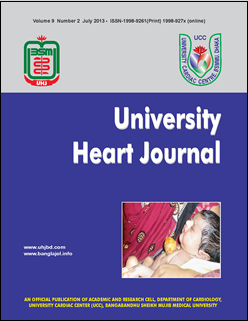Comparison between 2-dimensional and 3-dimensional echocardiographic scoring in predicting success of percutaneous transvenous mitral commissurotomy
DOI:
https://doi.org/10.3329/uhj.v9i2.23426Abstract
Like many other developing countries rheumatic heart disease still poses a great threat to the health system of this country due to its devastating outcome in inappropriately treated cases. PTMC remains a prime treatment option in suitable cases of rheumatic mitral stenosis. But there are controversies and discrepancies in the conventional 2-D echo assessment for proper selection of patients for PTMC. With the advent of newer technologies like 3-D echo with newer options, better assessments are naturally expected. This 3-D echo system raised the hope to fill the shortcomings of 2-D Wilkins score. To facilitate this 3-D echo with its scoring system it has to be testified against an established, widely accepted and well-understood existing scoring system that has its limitations. Thus it creates a fertile ground whereupon many studies are being done as it is chosen here. In this study, considering all ethical issues, data were collected from 50 mitral stenosis patients who were scored by means of 2-D Wilkins and RT3DE scoring systems prior to PTMC and reassessed echocardiographically to define post PTMC outcome and then from this result to compare the two scoring systems as predictors of outcome of PTMC. This study showed a clear female preponderance (78%) of mitral stenosis patients most of whom belonged to the age group 31-40 years. According to Wilkins score all are in the mild or moderate group but RT3DE scored 24% as severe. Both the 2-D mild and moderate groups had good number of suboptimal outcomes (34% and 24% respectively) although the moderate group had comparatively more optimal outcomes (76% in comparison to 66%) than the mild group (although the difference is not statistically significant), that is, the 2-D score is less consistent. On the other hand the RT3DE score showed a gradual fall of optimal outcome in an ascending order of the score from mild to severe and the differences in outcomes among different groups was statistically significant. This showed a clear superiority of the 3-D scoring system over the 2- D in terms of accuracy and consistency. In the 3-D severe group percentage of suboptimal outcome was very high(91.7%). This is the group of patients that were not correctly detected by 2-D echo and as a result the outcome assessment was far from accurate. Due to the higher accuracy and consistency 3-D echo is likely to be more reproducible than the 2-D, 3-D echocardiography was more accurate and consistent than 2-D echocardiography in assessing outcome of PTMC. So, the RT3DE scoring system can be a good supplement to the existing 2-D scoring system
University Heart Journal Vol. 9, No. 2, July 2013; 74-79
Downloads
215
227

